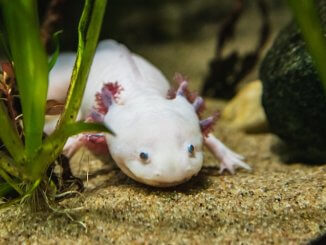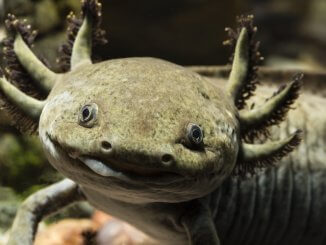Correct nutrition and a balanced diet are very important for the health and wellbeing of a Salamander.
A common misconception is that this amphibian should be fed every day.
Adults only need to be fed twice a week.
They should be fed a carnivorous diet that closely replicates what they eat in the wild (e.g. insects and small invertebrates). However, their exact diet depends on their age, species and natural environment.
When preparing your Salamander’s diet remember to vary what you feed and always cut into very small pieces.
To learn more about how to properly feed your salamander check out the rest of our article below…
What Do Salamanders Eat?
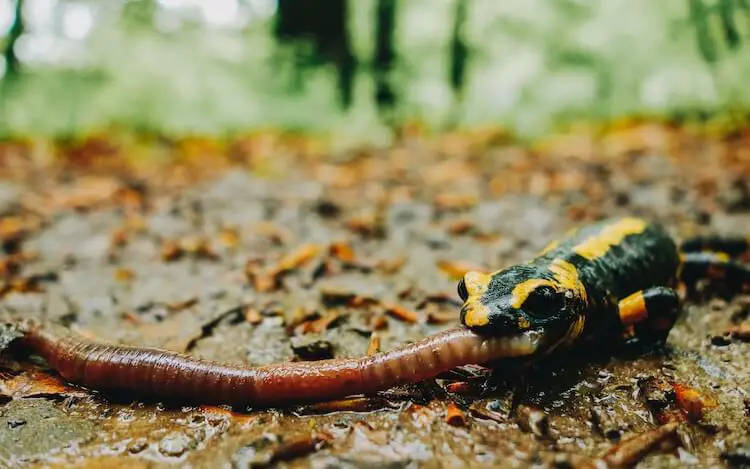
Salamanders are carnivores that eat a variety of insects and small invertebrates. They are vivacious eaters and are rarely picky about what they eat.
They are nocturnal amphibians that come out from their hiding spots at night to hunt for prey. Their natural habitat influences their diet, availability of prey and how often they eat. Most adults will eat once every two or three days.
A Salamander’s diet is mostly influenced by their species.
Salamanders are amphibians that can be divided into two distinct types:
- Aquatic
- Terrestrial
The terrestrial species has a sticky muscular tongue.
They use their tongue as a tool to catch a wide variety of prey including worms, flies, beetles, and grasshoppers.
Aquatic species don’t have sticky muscular tongues and are more reliant on their teeth to catch food. They eat organisms that are easier to catch such as worms, snails, and shrimp.
Unlike their terrestrial cousins, many aquatic species are omnivores (i.e. not just carnivorous). They will occasionally snack on algae and other plants found in their environment.
Larger species have been known to eat frogs, mice, and are sometimes cannibalistic.
| Terrestrial | Aquatic |
|---|---|
| A mixture of mealworms | A mixture of brine shrimp |
| Crickets | Minnows |
| Snails | Chopped blood worms |
| Variety of worms | Chopped night crawlers |
In captivity their natural feeding pattern should be replicated by using a consistent feeding schedule.
You should feed an adult once every two to three days.
Because juveniles are growing and frequently molting they will need to be fed every day. In captivity, there is an assortment of insects and other invertebrates that can be purchased to feed to them.
What Fruits and Vegetables Can Salamanders Eat?
They should not be fed any fruits or vegetables. Remember, they are carnivorous.
Fruits and vegetables are not a normal part of their diet in the wild.
Their digestive tracts cannot effectively process anything other than meat because they are carnivorous.
If fruits and vegetables are added to your salamander’s diet they will more than likely ignore them. The foods will then spoil and potentially expose your exotic pet to various pathogenic bacteria.
The best way for your pet to get the correct nutrients from fruits and vegetables is to use those food items to gut load insects that you feed them (there is more on gut loading below).
Commercial Food
There are a variety of nutritionally balanced pelleted diets available that are made from a variety of insects.
Despite being healthy to feed occasionally, you should not rely on these diets exclusively.
In captivity you should allow your amphibian to carry out natural hunting behaviors. They will quickly become bored of hunting commercial pellets. So you should only use a commercial diet to supplement your salamander’s diet.
Before feeding check the ingredients of the pellets to ensure it only contains food items from our safe list below.
Some captive species will refuse to eat a pellet-based diet from the start.
In addition to commercial diets it is possible to buy insects freeze dried instead of live.
Although, most freeze-dried insects aren’t as nutritious as live insects and some are not gut loaded.
Like commercial pellets, freeze-dried insects can still be included in their diet but should only be used occasionally.
Supplements
The only necessary supplement for salamanders is calcium powder. You should use calcium powder twice a week (i.e. each time you feed them).
If you decide to use a calcium supplement make sure it doesn’t include vitamin D3.
Vitamin D3 can be toxic at high levels for them so make sure the supplement has limited levels – or ideally none.
Multivitamins and other supplements are not necessary.
It is best to not include multivitamins in your salamander’s diet as they can be harmful.
Just make sure you feed a varied diet of different insects.
Salamander Diet
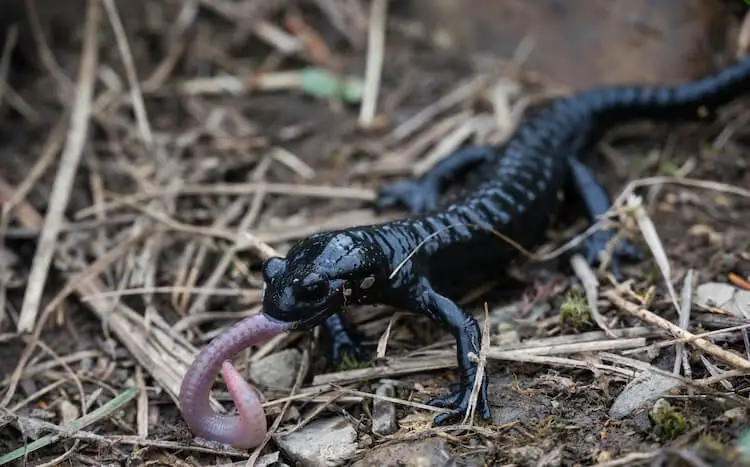
There are a variety of diseases and metabolic conditions that can affect this amphibian if they do not receive correct husbandry and diets.
Like most reptiles kept in captivity, they can develop metabolic bone disease if they do not receive proper amounts of calcium.
An inadequate diet will weaken their immune system and predispose them to many bacterial, fungal, and viral infections.
A Salamander’s nutritional requirements vary greatly throughout their lifetime.
As adults if prey is readily available they will eat lots and build up a large fat deposit. When food is scarce, or environmental conditions are inhospitable, they will enter periods of dormancy and greatly reduce their nutritional intake. They have been known to live for 10 days without food.
Juveniles need significantly more nutrients than adults for energy and growth.
Typically aquatic species tend to require more energy and nutrients than their terrestrial counterparts.
Adult Diet
At two to three months of age this species should be transitioned to an adult diet.
Adult salamanders should be fed two to three times each week.
For salamanders kept in captivity you should rotate their diet by choosing two food items to feed every other feeding session. This will help to keep your pet happy and healthy.
Each species prefers specific types of food. You should speak with a breeder to determine which prey items are best for your species.
Below is an example feeding schedule for an aquatic and terrestrial salamander:
| Day | Aquatic | Terrestrial |
|---|---|---|
| Monday | 2x brine shrimp, 1x inch of bloodworm |
1x mealworm, 2x crickets |
| Tuesday | Fast | |
| Wednesday | Fast | |
| Thursday | Fast | |
| Friday | 1x minnow, 1x inch of night crawler |
1x waxworm, 1x threadworm |
| Saturday | Fast | |
| Sunday | Fast | |
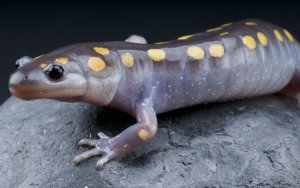
Salamanders have very small mouths. Worms and other larger food items must be finely chopped before being placed in their enclosure.
Because they are nocturnal they should be fed in the evening or at dusk.
When including live insects into your salamander’s diet it is imperative that you gut-load the insects for a couple of days before feeding.
To do this, place sweet potatoes, apples, and other fruits and vegetables in the insects’ enclosure for a few days. Gut loading ensures the insects are full of nutrients before beating eaten.
When kept in captivity, some exotic pets will become obese. This is a result of being fed too many high fat prey options.
Make sure you limit the number of mealworms and other nutrient-dense foods you feed.
Baby Diet
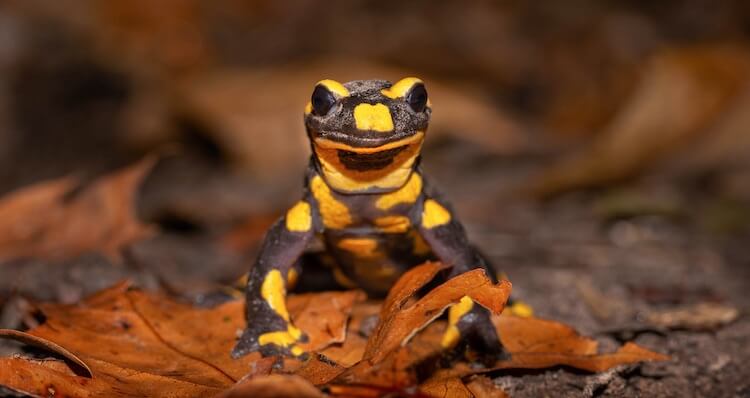
Baby salamanders should have a healthy appetite and readily accept food that is offered to them. If they refuse to eat then change the insects you are feeding or cut them into even smaller pieces.
After hatching, one of the first things a baby will do is eat the remnants of their shell. This is common for other reptiles too. A day or two later they will start eating small microorganisms found in water such as plankton.
At two weeks of age they will be large enough to start consuming larvae of smaller insect species. Mosquito larvae are a favorite snack.
When raising juveniles their diet can consist of:
- Baby brine shrimp
- Daphnia
- Finely chopped worms
Given their size, hatchlings only need a very small amount of food per day:
| Day | Feed |
|---|---|
| Monday | 2x brine shrimp |
| Tuesday | Multiple daphnia |
| Wednesday | 1x inch of chopped earthworm |
| Thursday | 2x brine shrimp |
| Friday | Multiple daphnia |
| Saturday | 1x inch of chopped earthworm |
| Sunday | 2x brine shrimp |
After a week of regular feeding, gradually increase their meal size and start to incorporate other insects and invertebrates. They will need to be fed every day to sustain their fast growth.
At four weeks of age you can transition to feeding every other day and then ultimately to once every two or three days. It takes hatchlings two months to grow large enough to eat the same diet as adults.
If there is excess food in the enclosure after feeding, cut back on how much you are feeding.
Spoiled food can lead to various health issues.
Common Feeding Mistakes
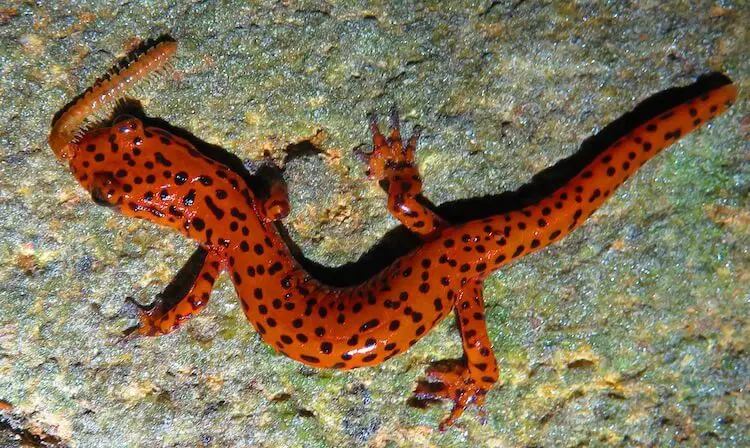
There are four feeding mistakes that owners commonly make when feeding:
- A lot of owners rely heavily on one type of food.
This species needs a variety of food to ensure that they receive a nutritionally balanced diet. Make sure you feed different foods on different days. This will keep your pet healthy and act as a form of enrichment.
- Beginners often forgot to gut load insects.
It is important to remember to gut load insects before feeding them. This will ensure your salamander receives proper nutrients.
- Don’t rely on a commercial diet.
Commercial diets are nutritionally balanced. However, commercial diets do not allow salamanders to carry out their natural hunting behaviors. If you choose to include a commercial diet in your feeding routine then supplement it with live prey.
- Overfeeding is common too.
If you feed an adult more than three times a week then excess food will build up in their enclosure and spoiled food will expose your pet to a variety of harmful bacteria. Make sure excess food isn’t left in the cage.
What Can’t Salamanders Eat?
In addition to fruits and vegetables not being heathy for a salamander, you should not feed red meat, chicken, or large fish. They will negatively affect the good bacteria in their intestine and cause chronic gastrointestinal issues.
Some insects are toxic to salamanders and should be avoided:
- Fireflies.
- Spiders.
- Ticks.
- Centipedes.
- Millipedes.
Fireflies contain a toxin called lucibufagin which is extremely toxic to reptiles and amphibians. Even ingesting one firefly could kill your salamander.
Chlorine and certain metals in water such as lead and zinc can also be deadly.
Provide them with deionized water or use an amphibian safe water filter to remove toxic substances.
Summary
Terrestrial salamanders have a very different diet than aquatics and enjoy eating worms, flies, beetles, and grasshoppers. Remember each species prefers different insects.
Feeding a suitable diet can be intimidating and overwhelming at first.
However, this exotic pet is actually very easy to feed.
Just make sure you provide them with different types of insects, cut the insects into very small pieces and rotate the insects you feed each meal time.
Don’t forget adults only need to be fed every two or three days!
If you have any questions or want to share your advice for feeding salamanders then let us know below!

